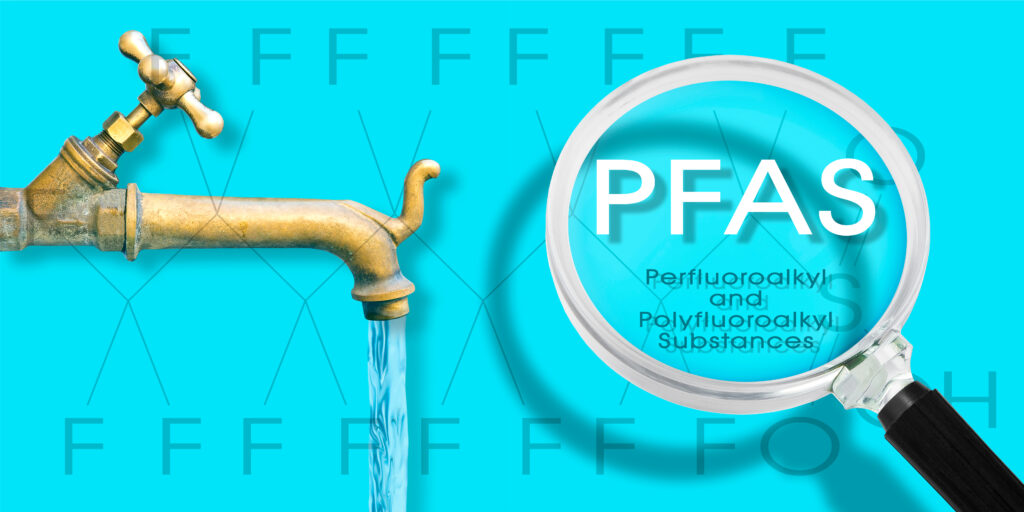Are PFAS Unhealthy – How To Avoid Products With PFAS
Per- and Polyfluoroalkyl Substances (PFAS) chemicals have been used for decades in a variety of products and many are now wondering, are PFAS unhealthy? As you will soon see, the answer is yes, PFAS are unhealthy. Let’s look at the detrimental health effects of PFAS and discuss how to avoid products that contain these chemicals.
PFAS chemicals are used in non-stick cookware, stain-resistant fabrics, waterproofing treatments, and firefighting foam. One of the main concerns with PFAS is their ability to bioaccumulate in the body. This means that these chemicals build up in our bodies over time rather than being flushed out. This is particularly concerning because PFAS have been shown to cause a range of health issues.1
Are PFAS Unhealthy – Developmental Delays
Developmental delays in children are one of the most concerning effects of PFAS exposure. PFAS chemicals are linked to a wide range of developmental issues including delays in motor skills, language development, and cognitive function.
Studies have shown that exposure to high levels of PFAS during critical stages of brain development can result in permanent damage to the developing brain. This leads to long-term consequences such as learning disabilities, behavioral problems, and reduced IQ.
The reason why PFAS are so detrimental to children’s health is due to their ability to cross the blood-brain barrier, which is a protective barrier that prevents harmful substances from entering the brain. Once inside, PFAS disrupts the delicate balance of hormones and neurotransmitters, which are essential for proper brain function and development.
PFAS have been found to cross the placenta and can be passed from mother to child during pregnancy or through breast milk. This means that even if children are not directly exposed to PFAS, they may still face health risks from these chemicals.
Moreover, PFAS have been linked to hormonal imbalances in children, which can further contribute to developmental delays. Hormones play a crucial role in regulating various bodily functions and processes, including growth and development. When these hormones are disrupted by PFAS exposure, it can lead to significant health issues in children.2

Are PFAS Unhealthy – Birth Defects
Studies have shown that maternal exposure to PFAS during pregnancy can affect the developing fetus and increase the risk of various birth defects. These include heart defects, cleft lip and palate, neural tube defects, and skeletal defects. PFAS chemicals have also been linked to low birth weight and preterm birth.3
Are PFAS Unhealthy – Immune System
Studies have found that exposure to PFAS chemicals suppresses the immune system, making individuals more susceptible to infections and illnesses. This is especially concerning for vulnerable populations such as children, pregnant women, and individuals with weakened immune systems.
Exposure to PFAS is also associated with increased levels of inflammation in the body. PFAS triggers the release of inflammatory cytokines and disrupts the immune system’s response, leading to chronic inflammation.4
Read more about the connection between inflammation and disease.
Are PFAS Unhealthy – Hormone Disruption
One potential risk associated with PFAS exposure is hormone disruption. Hormones are chemical messengers that play a crucial role in regulating bodily functions such as growth, metabolism, and reproduction. They work by binding to specific receptors in the body and triggering biological responses.
PFAS interfere with this process by binding to hormone receptors and either mimicking or blocking the action of natural hormones. This disrupts the delicate balance of hormones in the body and leads to a range of health problems.
One study found that exposure to PFAS disrupts the thyroid hormone system, which is responsible for controlling metabolism, growth, and development. This disruption has been linked to an increased risk of obesity and thyroid disease.
Read more about thyroid disease.
PFAS have also been shown to affect sex hormones such as estrogen and testosterone. In some cases, they can mimic estrogen and lead to an overstimulation of the body’s estrogen receptors. This is a concern because excessive estrogen levels have been linked to numerous health issues.
Read more about high estrogen levels.
In men, PFAS exposure has been associated with decreased testosterone levels and sperm quality, which can impact fertility and reproductive health. Additionally, animal studies have shown that PFAS interfere with the development of reproductive organs, leading to potential birth defects or other issues.
Read about low testosterone levels.
Research has also shown that PFAS exposure is linked to endocrine disorders such as polycystic ovary syndrome (PCOS) and insulin resistance. These conditions can have serious implications for overall health and increase the risk of chronic diseases.5
Read more about PCOS.

Are PFAS Unhealthy – Autoimmune Conditions
One area of concern is the link between PFAS exposure and autoimmune conditions. Autoimmune diseases occur when the immune system mistakenly attacks healthy cells and tissues, leading to inflammation and damage. Some examples of autoimmune conditions include multiple sclerosis, rheumatoid arthritis, and lupus.6
Studies have shown a connection between PFAS exposure and an increased risk of developing certain autoimmune diseases. Individuals with higher levels of PFAS in their blood were more likely to have the autoimmune disease ulcerative colitis.7
PFAS disrupts the immune system and triggers an autoimmune response in susceptible individuals. As stated before, some of these chemicals have been found to mimic hormones in the body, which can also contribute to autoimmune disorders.8
Are PFAS Unhealthy – Metabolic Disorders
Research has shown that PFAS can cause a variety of adverse health effects, including metabolic disorders. Metabolism is the process by which our bodies convert food into energy and build tissue. When this process is disrupted, it leads to a range of health issues such as obesity and high cholesterol.
One study found that exposure to certain types of PFAS was associated with weight gain and insulin resistance in children. When PFAS interfere with the functioning of hormones, it negatively affects metabolism.9
Are PFAS Unhealthy – Gut Microbiota
PFAS have been found to alter gut microbiota, the community of bacteria that live in our digestive system. These bacteria play a crucial role in metabolism by breaking down food and producing essential nutrients. Disrupting this delicate balance can have a significant impact on metabolic health.
Studies have shown that exposure to PFAS leads to changes in the gut microbiota composition and diversity. One study found that individuals with higher levels of PFAS in their blood had lower levels of beneficial bacteria, such as Bifidobacterium and Lactobacillus. These bacteria are known to promote a healthy gut environment and support immune function.
Furthermore, PFAS have been linked to an increase in harmful bacteria, such as Clostridium and Bacteroides. These bacteria have been associated with various health issues, including obesity, inflammation, and insulin resistance.10

Are PFAS Unhealthy – Respiratory Issues
Studies have shown that exposure to certain types of PFAS leads to a range of respiratory issues. One particular type of PFAS, known as perfluorooctanoic acid (PFOA), has been linked to an increased risk of asthma and other respiratory conditions. PFOA has also been found to suppress the immune system, making individuals more susceptible to respiratory infections.
Additionally, exposure to PFAS can lead to lung damage and inflammation, which can result in breathing difficulties and reduced lung function. This is especially concerning for individuals who already have respiratory issues, as exposure to PFAS can worsen their conditions.11
Are PFAS Unhealthy – Liver Damage
Studies on animals have shown that exposure to high levels of PFAS can lead to liver damage. These chemicals are known to accumulate in the liver and disrupt its normal functioning, leading to inflammation, fibrosis (scarring), and even tumors.
Several epidemiological studies have linked PFAS exposure to liver damage in humans as well. For instance, a study found that individuals with higher levels of PFAS in their blood were more likely to have elevated liver enzymes, a marker of liver damage.12
Another study also found a significant association between PFAS exposure and non-alcoholic fatty liver disease (NAFLD). NAFLD is a condition where excess fat builds up in the liver, leading to inflammation and damage.13
Read more about NAFLD.
Are PFAS Unhealthy – How To Avoid Products With PFAS
PFAS have been found to be persistent in the environment and can travel long distances through air, water, and soil. This means that even if you are not directly exposed to products containing PFAS, you could still come into contact with them through contaminated water or food sources. In fact, 45% of tap water in the United States was shown to contain PFAS.14

In response to these concerns, many countries have taken steps to limit or ban the use of certain types of PFAS. However, given their widespread use and persistence in the environment, the cat is already out of the bag.
It is important for individuals to be aware of products that contain PFAS and take steps to minimize their exposure. This can include avoiding non-stick cookware, avoiding fast food packaging, avoiding typical personal care products, opting for natural and organic fabrics, consuming reputable spring water or RO water, and being cautious when using firefighting foam.
Read more about other toxins we are exposed to.
References
1 Fenton SE, Ducatman A, Boobis A, DeWitt JC, Lau C, Ng C, Smith JS, Roberts SM. Per- and Polyfluoroalkyl Substance Toxicity and Human Health Review: Current State of Knowledge and Strategies for Informing Future Research. Environ Toxicol Chem. 2021 Mar;40(3):606-630. doi: 10.1002/etc.4890. Epub 2020 Dec 7. PMID: 33017053; PMCID: PMC7906952.
2 Liew Z, Goudarzi H, Oulhote Y. Developmental Exposures to Perfluoroalkyl Substances (PFASs): An Update of Associated Health Outcomes. Curr Environ Health Rep. 2018 Mar;5(1):1-19. doi: 10.1007/s40572-018-0173-4. PMID: 29556975; PMCID: PMC6348874.
3 Stein CR, Savitz DA, Elston B, Thorpe PG, Gilboa SM. Perfluorooctanoate exposure and major birth defects. Reprod Toxicol. 2014 Aug;47:15-20. doi: 10.1016/j.reprotox.2014.04.006. Epub 2014 May 4. PMID: 24803403; PMCID: PMC4117925.
4 von Holst H, Nayak P, Dembek Z, Buehler S, Echeverria D, Fallacara D, John L. Perfluoroalkyl substances exposure and immunity, allergic response, infection, and asthma in children: review of epidemiologic studies. Heliyon. 2021 Oct 12;7(10):e08160. doi: 10.1016/j.heliyon.2021.e08160. PMID: 34712855; PMCID: PMC8529509.
5 Mokra K. Endocrine Disruptor Potential of Short- and Long-Chain Perfluoroalkyl Substances (PFASs)-A Synthesis of Current Knowledge with Proposal of Molecular Mechanism. Int J Mol Sci. 2021 Feb 21;22(4):2148. doi: 10.3390/ijms22042148. PMID: 33670069; PMCID: PMC7926449.
6 Ehrlich V, Bil W, Vandebriel R, Granum B, Luijten M, Lindeman B, Grandjean P, Kaiser AM, Hauzenberger I, Hartmann C, Gundacker C, Uhl M. Consideration of pathways for immunotoxicity of per- and polyfluoroalkyl substances (PFAS). Environ Health. 2023 Feb 22;22(1):19. doi: 10.1186/s12940-022-00958-5. PMID: 36814257; PMCID: PMC9944481.
7 National Academies of Sciences, Engineering, and Medicine; Health and Medicine Division; Division on Earth and Life Studies; Board on Population Health and Public Health Practice; Board on Environmental Studies and Toxicology; Committee on the Guidance on PFAS Testing and Health Outcomes. Guidance on PFAS Exposure, Testing, and Clinical Follow-Up. Washington (DC): National Academies Press (US); 2022 Jul 28. 3, Potential Health Effects of PFAS. Available from: https://www.ncbi.nlm.nih.gov/books/NBK584690/
8 Desai MK, Brinton RD. Autoimmune Disease in Women: Endocrine Transition and Risk Across the Lifespan. Front Endocrinol (Lausanne). 2019 Apr 29;10:265. doi: 10.3389/fendo.2019.00265. PMID: 31110493; PMCID: PMC6501433.
9 Qi W, Clark JM, Timme-Laragy AR, Park Y. Per- and Polyfluoroalkyl Substances and Obesity, Type 2 Diabetes and Non-alcoholic Fatty Liver Disease: A Review of Epidemiologic Findings. Toxicol Environ Chem. 2020;102(1-4):1-36. doi: 10.1080/02772248.2020.1763997. Epub 2020 May 22. PMID: 33304027; PMCID: PMC7723340.
10 Laue HE, Moroishi Y, Palys TJ, Christensen BC, Criswell RL, Peterson LA, Huset CA, Baker ER, Karagas MR, Madan JC, Romano ME. Early-life exposure to per- and polyfluoroalkyl substances and infant gut microbial composition. Environ Epidemiol. 2022 Dec 14;7(1):e238. doi: 10.1097/EE9.0000000000000238. PMID: 36777525; PMCID: PMC9916123.
11 von Holst H, Nayak P, Dembek Z, Buehler S, Echeverria D, Fallacara D, John L. Perfluoroalkyl substances exposure and immunity, allergic response, infection, and asthma in children: review of epidemiologic studies. Heliyon. 2021 Oct 12;7(10):e08160. doi: 10.1016/j.heliyon.2021.e08160. PMID: 34712855; PMCID: PMC8529509.
12 Bassler J, Ducatman A, Elliott M, Wen S, Wahlang B, Barnett J, Cave MC. Environmental perfluoroalkyl acid exposures are associated with liver disease characterized by apoptosis and altered serum adipocytokines. Environ Pollut. 2019 Apr;247:1055-1063. doi: 10.1016/j.envpol.2019.01.064. Epub 2019 Jan 18. PMID: 30823334; PMCID: PMC6404528.
13 Jin R, McConnell R, Catherine C, Xu S, Walker DI, Stratakis N, Jones DP, Miller GW, Peng C, Conti DV, Vos MB, Chatzi L. Perfluoroalkyl substances and severity of nonalcoholic fatty liver in Children: An untargeted metabolomics approach. Environ Int. 2020 Jan;134:105220. doi: 10.1016/j.envint.2019.105220. Epub 2019 Nov 16. PMID: 31744629; PMCID: PMC6944061.
14 Tap water study detects PFAS ‘forever chemicals’ across the US | U.S. Geological Survey. (2023, June 23). https://www.usgs.gov/news/national-news-release/tap-water-study-detects-pfas-forever-chemicals-across-us




